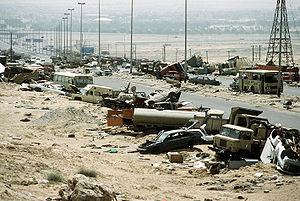Highway 80 (Kuwait)
| Highway of Death | |||||||
|---|---|---|---|---|---|---|---|
| Part of the Persian Gulf War | |||||||
 Wrecked and abandoned vehicles along Highway 80 in April 1991 |
|||||||
|
|||||||
| Belligerents | |||||||
|
|
|
||||||
| Casualties and losses | |||||||
| None | Estimates range from ~200–300 to >10,000 killed and ~2,000 captured Est. 1,800–2,700 vehicles |
||||||
The Highway of Death (Arabic: طريق الموت ṭarīq al-mawt) refers to a six-lane highway between Kuwait and Iraq, officially known as Highway 80. It runs from Kuwait City to the border town of Safwan in Iraq and then on to the Iraqi city of Basra. The road had been used by Iraqi armored divisions for the 1990 Invasion of Kuwait. The road was repaired after the Persian Gulf War and used by U.S. and British forces in the initial stages of the 2003 invasion of Iraq.
During the United Nations coalition offensive in the Persian Gulf War, American, Canadian, British and French aircraft and ground forces attacked retreating Iraqi military personnel attempting to leave Kuwait on the night of February 26–27, 1991, resulting in the destruction of hundreds of vehicles and the deaths of many of their occupants. U.S. attacks against the Iraqi columns were actually conducted on two different roads. Between 1,400 and 2,000 vehicles were hit or abandoned on the main Highway 80 north of Al Jahra (the "actual" Highway of Death). Several hundred more littered the lesser known Highway 8 to the major southern Iraq military stronghold of Basra.
The scenes of devastation on the road are some of the most recognizable images of the war, and it has been suggested that they were a factor in President George H. W. Bush's decision to declare a cessation of hostilities the next day. Many Iraqi forces, however, successfully escaped across the Euphrates river, and the U.S. Defense Intelligence Agency estimated that upwards of 70,000 to 80,000 troops from defeated divisions in Kuwait might have fled into Basra, evading capture.
The US navy's 3rd Marine Aircraft Wing's A-6 Intruder aircraft blocked Highway 80, bombarding a massive vehicle column of mostly Iraqi Regular Army forces with Mk-20 Rockeye II cluster bombs, effectively boxing in the Iraqi forces in an enormous traffic jam of sitting targets for subsequent airstrikes. Over the next 10 hours, scores of U.S. Marine and U.S. Air Force aircraft and U.S. Navy pilots from USS Ranger (CV/CVA-61) attacked the convoy using a variety of ordnance. Vehicles surviving the air attacks were later engaged by arriving coalition ground units, while most of the vehicles that managed to evade the traffic jam and continued to drive on the road north were targeted individually. The road bottle-neck near the Mutla Ridge police station was reduced to a long uninterrupted line of more than 300 stuck and abandoned vehicles sometimes called the Mile of Death. The wreckage found on the highway consisted of at least 28 tanks and other armored vehicles with many more commandeered civilian cars and buses filled with stolen Kuwaiti property.
...
Wikipedia
